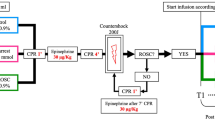Abstract
Evidence from both clinical and experimental studies demonstrates that mild hypothermia prevents encephalopathy and brain edema in acute liver failure (ALF). As part of a series of studies to elucidate the mechanism(s) involved in this protective effect, groups of rats with ALF resulting from hepatic devascularization were maintained at either 37°C (normothermic) or 35°C (hypothermic), and neurological status was monitored in relation to cerebrospinal fluid (CSF) concentrations of ammonia and lactate. CSF was removed via implanted cisterna magna catheters. Mild hypothermia resulted in a delay in onset of encephalopathy and prevention of brain edema; CSF concentrations of ammonia and lactate were concomitantly decreased. Blood ammonia concentrations, on the other hand, were not affected by hypothermia in ALF rats. These findings suggest that brain edema and encephalopathy in ALF are the consequence of ammonia-induced impairment of brain energy metabolism and open the way for magnetic resonance spectroscopic monitoring of cerebral function in ALF. Mild hypothermia could be beneficial in the prevention of severe encephalopathy and brain edema in patients with ALF awaiting liver transplantation.
Similar content being viewed by others
REFERENCES
Alexander, S.C., Workman, R.D., and Lambertsen, C.J. (1962). Hyperthermia, lactic acid infusion, and the composition of arterial blood and cerebrospinal fluid. Am. J. Physiol. 202:1049–1054.
Busto, R., Globus, M.Y.T., Dietrich, W.D., Martinez, E., Valdes, I., and Ginsberg, M.D. (1989). Effect of mild hypothermia on ischemia-induced release of neurotransmitters and free fatty acids in rat brain. Stroke 20:904–910.
Clemmensen, J.O., Larsen, F.S., Kondrup, J., Hansen, B.A., and Ott, P. (1999). Cerebral herniation in patients with acute liver failure is correlated with arterial ammonia concentration. Hepatology 29:648–63.
Cordoba, J., and Blei, A.T. (1996). Brain edema and hepatic encephalopathy. Semin. Liver Dis. 16:271–280.
Deutz, N.E.P., De Graaf, A.A., De Haan, J.G., Bovée, W.M.M.J., and Chamuleau, R.A.F.M. (1988). In vivo brain 1H-NMR spectroscopy (1H-NMRS) during acute hepatic encephalopathy (HE). In (P.B. Soeters, J.H.P. Wilson, A.J. Meijer, and E. Holm, eds.) Advances in Ammonia Metabolism and Hepatic Encephalopathy, Chap. 57, Excerpta Medica, Amsterdam, pp. 439–446.
Dietrich, W.D., Alonso, O., Busto, R., Globus, M.Y.T., and Ginsberg, M.D. (1994). Post-traumatic brain edema hypothermia reduces histopathological damage following concussive brain injury in the rat. Acta Neuropathol. 87:250–258.
Fazekas, J.F., Ticktim, H.E., Ehrmantraut, W.R., and Alman, R.W. (1956). Cerebral metabolism in hepatic insufficiency. Am. J. Med. 21:843.
Hawkins, R.A., Miller, A.L., Nielsen, R.C., and Veech, R.L. (1973). The acute action of ammonia on rat brain metabolism in vivo. Biochem. J. 134:1001–1008.
Hindfelt, B., Plum, F., and Duffy, T.E. (1977). Effects of acute ammonia intoxication on cerebral metabolism in rats with portacaval shunts. J. Clin. Invest. 59:386–396.
Holmin, T., Agardh, C.D., Alinder, G., Herlin, P., and Hultberg, B. (1983). The influence of total hepatectomy on cerebral energy state, ammonia-related amino acids of the brain and plasma amino acids in the rat. Eur. J. Clin. Invest. 13:215–220.
Jalan, R., Dalmink, S.W.M., O, Lee, A., and Hayes, P.C. (1999). Moderate hypothermia for uncontrolled intracranial hypertension in acute liver failure. Lancet 354:1164–1168.
Kosenko, E., Kaminsky, Y., Grau, E., Minana, M.D., Marcaida, G., Grisolia, S., and Felipo, V. (1994). Brain ATP depletion induced by acute ammonia intoxication in rats is mediated by activation of the NMDA receptor and Na+, K+-ATPase. J. Neurochem. 63:2172–2178.
Lai, J.C.K., and Cooper, A.J.L. (1986). α-ketoglutarate dehydrogenase complex: Kinetic properties, regional distribution and effects of inhibitors. J. Neurochem. 47:1376–1386.
Lee, S., and Fisher, B. (1961). Portacaval shunt in the rat. Surgery 50:668–672.
Mans, A.M., DeJoseph, R., and Hawkins, R.A. (1994). Metabolic abnormalities and grade of encephalopathy in acute liver failure. J. Neurochem. 63:1829–1838.
McKhann, G.M., and Tower, D.B. (1961). Ammonia toxicity and cerebral oxidative metabolism. Am. J. Med. 200:420.
Posner, J.B., and Plum, F. (1967). Independence of blood and cerebrospinal fluid lactate. Arch. Neurol. 16:492–496.
Rose, C., Michalak, A., Rama Rao, K.V., Quack, G., Kircheis, G., and Butterworth, R.F. (1999). L-Ornithine-L-Aspartate lowers plasma and cerebrospinal fluid ammonia and prevents brain edema in rats with acute liver failure. Hepatology 30:636–640.
Rose, C., Michalak, A., Pannunzio, M., Chatauret, N., Rambaldi, A., and Butterworth, R.F. (2000). Mild hypothermia delays the onset of coma and prevents brain edema and extracellular brain glutamate accumulation in rats with acute liver failure. Hepatology 31:872–877.
Schenker, S., and Warren, K.S. (1962). Effect of temperature variation on toxicity and metabolism of ammonia in mice. J. Lab. Clin. Med. 60:291–301.
Staub, F., Baethmann, A., Peters, J., Weigt, H., and Kempski, O. (1990). Effects of lactacidosis on glial cell volume and viability. J. Cereb. Blood Flow Metab. 10:866–876.
Swain, M., Butterworth, R.F., and Blei, A.T. (1992a). Ammonia and related amino acids in the pathogenesis of brain edema in acute ischemic liver failure in rats. Hepatology 15:449–453.
Swain, M., Bergeron, M., Audet, R., Blei, A.T., and Butterworth, R.F. (1992b). Monitoring of neurotransmitter amino acids by means of an indwelling cisterna magna catheter: A comparison of two rodent models of fulminant hepatic failure. Hepatology 16:1028–1035.
Therrien, G., Giguère, J.-F., and Butterworth, R.F. (1991). Increased cerebrospinal fluid lactate reflects deterioration of neurological status in experimental portal-systemic encephalopathy. Metab. Brain Dis. 6:225–231.
Traber, P., DalCanto, M., Ganger, D., and Blei, A.T. (1989). Effect of body temperature on brain edema and encephalopathy in the rat after hepatic devascularization. Gastroentology 96:885–891.
Yao, H., Sadoshima, S., Fujii, D., Kusada, K., Ishitsuka, T., Tamaki, K., and Fujishima, M. (1987). Cerebrospinal fluid lactate in patients with hepatic encephalopathy. Eur. Neurol. 27:182–187.
Author information
Authors and Affiliations
Corresponding author
Rights and permissions
About this article
Cite this article
Chatauret, N., Rose, C., Therrien, G. et al. Mild Hypothermia Prevents Cerebral Edema and CSF Lactate Accumulation in Acute Liver Failure. Metab Brain Dis 16, 95–102 (2001). https://doi.org/10.1023/A:1011622830569
Issue Date:
DOI: https://doi.org/10.1023/A:1011622830569




